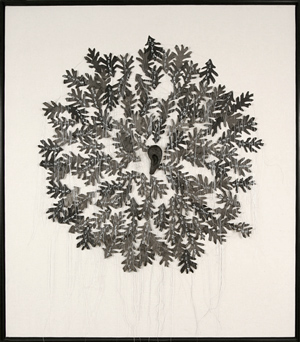WORDSMITH
Lesley Dill uses language as her muse
by Doug MacCash, THE TIMES-PICAYUNE
New York-based artist Lesley Dill, whose work is on display at Arthur Roger Gallery through Saturday, is largely responsible for one of the most popular trends in sculpture. Whenever you see ghostly objects made from ephemeral materials such as sheer cloth, papier-mache and dangling ribbons and threads, think of Dill. This is especially true if the artist adds passages of writing to the sculpture, not the big, bold, BANG, ZOOM, CRASH lettering of Pop and graffiti, but the faint, tentative script of a shy little girl.
The current show is vintage Dill, the kind of tour de force suite of works that has made her a star. “Blue” is the translucent figure of a woman wearing a long flowing skirt, constructed from a loosely woven wire net, coated with a thin veil of pale blue thread. Projecting from her shoulders and head is a halo of words that spell out passages from Dill’s regular source of inspiration, Emily Dickinson: “It is a lonesome glee, yet sanctifies the mind, a spider sewed at night.”
Another piece, “I Have Given My Life to Words,” is a man’s black suit with lettering cut into the fabric — so much lettering that the suit is an almost shapeless, ragged mass. “Still” is a 20-foot-long curtain made of miles of straw-colored thread cascading from a passage by Franz Kafka. “I Heard a Voice, Number 1” is a papier-mache ear surrounded by an aurora of black oak leaves, implying (in my reading anyway) that we can sometimes hear familiar voices in the sound of rustling leaves. And “Blonde Push” (also based on Dickinson) is a cascade of yellow-gray strands, each meticulously woven from several lengths of horse hair, gushing from a line of text.

I Heard a Voice, No. 1
Lesley Dill”s ”I Heard a Voice, Number 1,” made of papier-mache and cloth leaves, is a haunting metaphor for imagining voices in windblown leaves.
In a recent phone conversation Dill, 54, was humbly reluctant to take credit for her widespread influence. “Every time someone says to me, ”I know your work,” I think it’s a miracle,” she said.
The ideas that fueled her popularity were “in the air,” she believes, as much a product of the times as of her talent. In her view, critics and collectors love her fragile, ephemeral works, in part, because they are a respite from the massive, permanent, bronze and steel art of the past.
“If you look at works by Rodin or Di Suvero, they”re very weighty,” she said, “but now, sculpture has opened out to include things that are light. I love that edge, between the air and the material, where something just comes into being. I love that sparkle.
“I think there is this craving, this interest in tactility. It allows us — the viewer — to engage more with the materials. And also, life is temporary. There’s room to have more delicate feelings. Maybe the viewer can experience that sense of delicacy. You don’t just say, ”Whew, this sculpture is big and I’m so small.” ”
Another “in the air” reason for the broad appeal of Dill’s word-sculpture may be the proliferation of home computers. The regular use of e-mail, Dill suspects, has made the general public more sensitive to the precise use of language.
She traces her own lifelong love of words to her mother, a high school speech and drama teacher. “I had grown up as such a reader,” she said. “The world behind the words was so real to me that words became like little people. They mean something, even if they’re in a different language. Even if you don”t understand them, they have a presence.
“I’d always been a little too speedy for poetry. I’d always be at the bottom of the page, before any of the words sunk in. Then my mother gave me an Emily Dickinson book 14 years ago. Her words bypassed my intellect and went right into my art-making place.”
Dill’s right of course, artistic ideas do seem to flow through the air. There are always art historical imperatives out there waiting to be discovered and satisfied. If Jackson Pollock hadn”t splattered paint, somebody else doubtlessly would have.
But Dill also sells herself short. Sure, ideas are in the air, but you have to be sensitive enough to notice them, artistically agile enough to capture them and dedicated enough to see them through to their conclusion no matter how many strands of horse hair you have to knot to do it.
